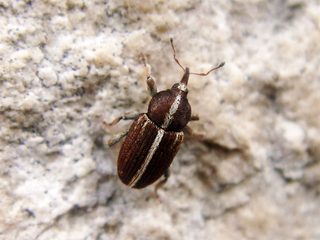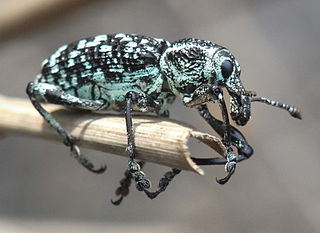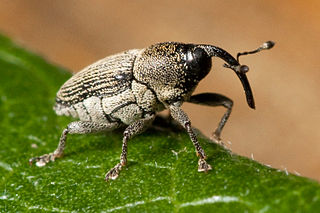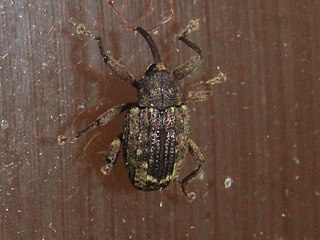
The Curculionidae are a family of weevils, commonly called snout beetles or true weevils. They are one of the largest animal families with 6,800 genera and 83,000 species described worldwide. They are the sister group to the family Brentidae.

Sitophilus is a genus of weevils in the tribe Litosomini. Some species are familiar as pests of stored grain, nut, or seed. Notable pest species include the rice weevil, wheat weevil, and maize weevil.

The beetle subfamily Curculioninae is part of the weevil family Curculionidae. It contains over 23,500 described species in 2,200 genera, and is therefore the largest weevil subfamily. Given that the beetle order (Coleoptera) contains about one-quarter of all known organisms, the Curculioninae represent one of the – if not the – most successful radiations of terrestrial Metazoa.

Chrysolopus spectabilis is a species of weevil found in south-eastern Australia. It was discovered during James Cook's first voyage, and became one of the first insects to be described from Australia. The weevil measures up to 25 mm (1.0 in) long and includes distinctive metallic green and black scales. It is found only on 28 species of the plant genus Acacia.

Curculio nucum, the nut weevil, is a medium-sized beetle, with an especially elongated snout, characteristic of the Curculionini tribe of the weevil family (Curculionidae). Its larvae develop in hazel nuts Corylus avellana, being a serious pest in hazelnut orchards. It occurs in most of Europe, from south Sweden, Finland and Great Britain to the Mediterranean.

Sitona is a large genus of weevils in the family Curculionidae native to the Nearctic and Palaearctic regions. Over 100 species have been described. Sitona is easily distinguished from related genera by flat, recumbent scales on the mandibles, by the absence of an oval scar on the mandibles, by short and broad rostrum with a deep, longitudinal, median groove, and by dense scales on the body.

Phyllobius glaucus is a species of weevil found across Europe, especially in carrs. It is a pest of a variety of fruit trees, but has little economic effect. It was first described by Giovanni Antonio Scopoli in 1763.

The pecan weevil, Curculio caryae is an obligate feeder on the nuts of North American hickories and pecans, most widely recognized as an economically important pest of the pecan, Carya illinoinensis. It has also been observed to infest one Juglans species, the Persian walnut, Juglans regia.

Curculio occidentis, the filbert weevil, is a species of weevil in the genus Curculio. The weevils are considered a pest for many species of oak tree due to the damage they cause to acorns.

Sternochetus mangiferae is a weevil commonly known as the mango seed weevil, mango stone weevil, or mango weevil. It is a compact weevil typical of the Cryptorhynchinae. It was first described in 1775 in the genus Curculio. The adults are 7.5-9.5 mm long and 4 mm in width.

Sphenophorus is a genus of weevils, often known as billbugs, in the family Curculionidae, and tribe Sphenophorini. Eleven species of billbugs infest managed turfgrass in North America.

Curculio elephas is a species of beetle in the family Curculionidae, the true weevils. It is known commonly as the chestnut weevil. It is a serious pest of chestnut in Europe.

Anchylorhynchus is a genus of weevils belonging the family Curculionidae and subfamily Curculioninae. It currently includes 25 described species distributed from Panama to Argentina. Members of the genus are pollinators of palms in the genera Syagrus, Oenocarpus and Butia, with adults living in inflorescences and larvae feeding on developing fruits. The first instar larvae of Anchylorhynchus have an unusual morphology, being specialized on killing other larvae infesting the palm fruits.

Apostasimerini is a tribe of flower weevils in the family of beetles known as Curculionidae. There are over 240 genera and nearly 1700 described species in Apostasimerini.
Tachygonus is a genus of flea weevils in the beetle family Curculionidae. There are more than 80 described species in Tachygonus.
Coccotorus is a genus of true weevils in the beetle family Curculionidae. There are about six described species in Coccotorus.

Curculio sayi, the small or lesser chestnut weevil, is a species of true weevil in the family of beetles known as Curculionidae.

The Conotrachelus posticatus is a species of true weevil within the beetle family Curculionidae. C. posticatus is found in North America. It is on average 3.7–5 mm (0.15–0.20 in) long, and it is present in North America all the way to Panama. This species of Conotrachelus breeds in acorns; as a result, its larvae are found within acorns and their larval diet includes acorns. Their growing presence within oak trees has been studied and their effect on oak trees shows that they attack these trees by destroying the seeds within the tree. At times, the seeds can be found to be partially damaged, and requires further studying to understand the activity of the species in relation to oak trees.
Frank Hurlbut Chittenden was an American coleopterist and economic entomologist who worked in the US Department of Entomology.

Cyrtomon is a genus of broad-nosed weevils in the beetle family Curculionidae, present only in South America. There are six described species in Cyrtomon.



















